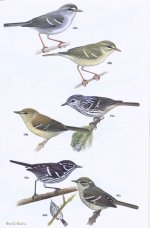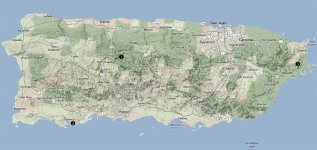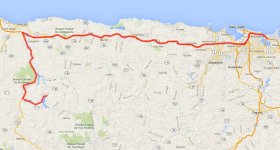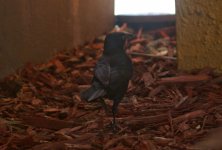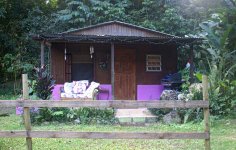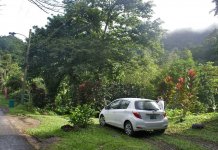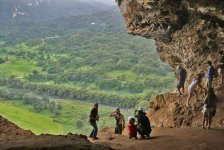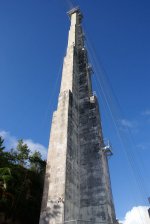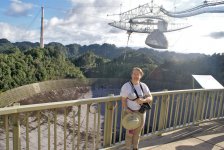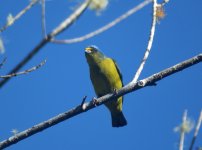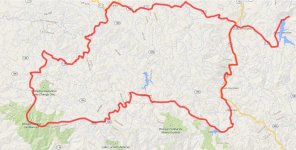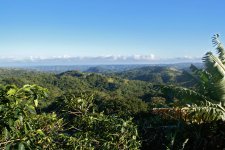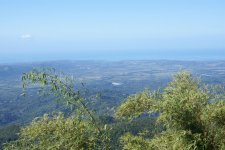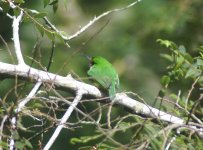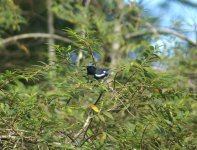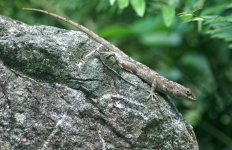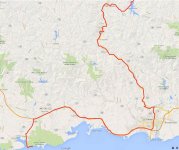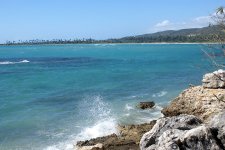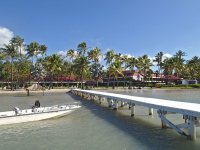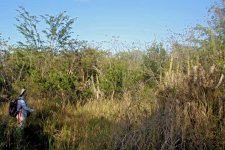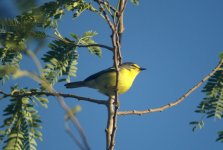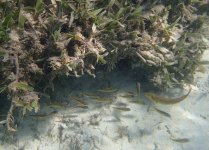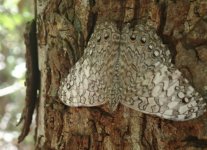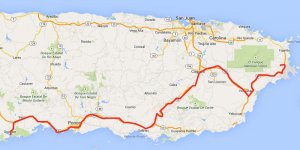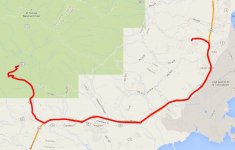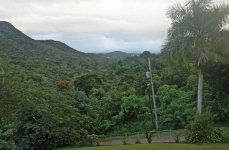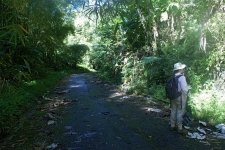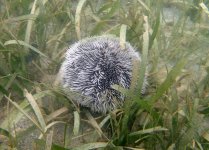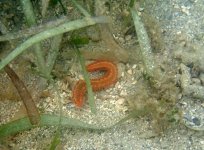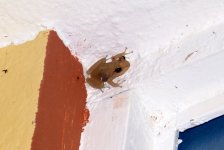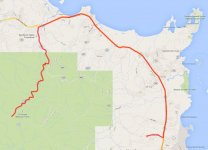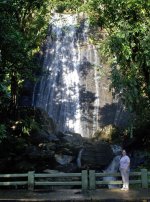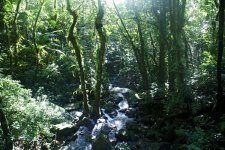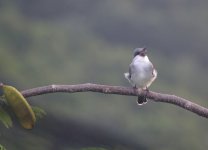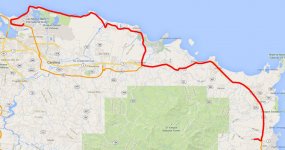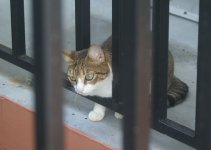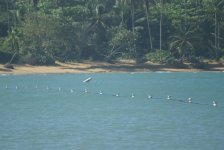Day 4: Utuado – Copamarina Beach Resort
Today was our day to switch habitats – from the temperate moist forests of the Cordillera Central to the very much drier climes of the south coast.
However, before leaving, we went for one more walk from the Casita. There was a set of nature trails in back of the Hotel Casa Grande, just across the road, so we decided we should take advantage of those. It turned out, there is not a bad network up there – they would have been worth more exploration, if we had just had more time for it. As it was, we only went for a short walk so we didn’t see much – mostly just more todies and euphonias.
On our way out to the main road, we had a look into the nearby Lago Caonillas. We had passed this way about five times over the last two days, but this was the first time we’d had a chance to stop. This time, we took the time to set up the scope, and stare out at some distant black dots out there – which resolved themselves into Pied-billed Grebes. Otherwise, the lake seemed quite barren of (surface) life. But this stop was fortuitous in another way; as we were scanning the water, we heard a series of unfamiliar ‘whoops’ coming from the tall stands of bamboo behind us – some sort of dove, perhaps? Since we’d arrived in Utuado, we’d been seeing large, dark pigeon-shapes flying around up high – but had to leave them unidentified, since I certainly wasn’t about to try to do them based on profile alone. Here, however, it seemed that one or two were perched, and right by the road too! After a few minutes, we were able to locate one, and even got it in the scope – Scaly-naped Pigeon.
Then, it was back out through the ‘downtown’ of Utuado one last time, and out to the main highway south towards Ponce. This road was even more hairy then yesterday, because in addition to the unrelenting twistiness, it had also been slicked down by an early-morning drizzle. Past the town of Adjuntas, however, the road became a lot more agreeable, largely due to its actually being finished (i.e., twinned) along that section. The south coast of Puerto Rico is, as I have suggested, quite different in climate from where we had been. It is, I would imagine, in the ‘rain shadow’ of the central hills, because the forest type changes dramatically, becoming sparser, semi-deciduous, with some cacti interspersed amongst the trees.
Again today, I found it difficult to judge transit times on this small island – with the result that we arrived at our new stop-over, the Copamarina Beach Resort, around noon. This was much, much too early for check-in, which was at 1500. I asked anyway, but nothing doing, no room were ready. (Oh, well, the previous evening
had been New Year’s, I suppose the staff were still recovering…) So, with all our baggage still aboard "the Box," we drove a bit west to the small coastal town of La Parguera. As Maricao is to the Elfin-woods Warbler, this town is to another endangered Puerto Rican endemic, the Yellow-shouldered Blackbird. Wheatly & Brewer even goes so far as to direct one to a particular hotel, the Villa Parador, which the blackbirds are said to visit “to feed on scraps.” Turns out that this hotel is right in the middle of a busy, very commercialized, and very loud town. There doesn’t seem to be anywhere near this hotel for an icterid of any kind to come in and roost, never mind a rare one! There was a little public square to the next to the hotel, but it was filled with the strains of the latest in the hip-hop hit parade (coming over the PA system, no less!).
La Parguera had a bit of a “quayside” walk along its waterfront, which took us past the docks of the various tour boat companies (the main local attraction being a nearby bioluminescent bay), so we wandered along that for a while, peering hopefully into what fragments of mangrove still stood. We did find three new birds- all exotics - Eurasian collared-dove, Nutmeg Mannikin, and Indian Siverbill, but no blackbirds, of any sort. I was not impressed with this town (but I must concede, mid-afternoon was far from the ideal time to be birding here).
[Aside]According to our book (Where to Bird....), Puerto Rico has the dubious distinction of hosting the largest number of established introduced species of any island in the Caribbean basin. Now, look: I don’t want to start that debate here, okay? (You know the one I mean). But, as for me, myself, and I – I can say that none of these were particularly interesting, to me. I just can't be bothered wading into the whole "established vs. feral" debate, so I don't count exotics at all - any more. (Yes, I have House Sparrow on my life list in Ontario - and European Goldfinch in South Australia, for that matter! But that's just laziness, I couldn't be bothered going back and pulling these out of my life list. I just consider them as 'grandfathered' in.) However, I recognize that some people - probably most people - do not feel as I do, so I still report these here. [/aside]
We still had an hour or so to go before the hotel would let us into our room, so we did some exploring on our way back to Guánica. Our map showed an area marked as wetland just inland from the coast road a bit, and had a small lake (Lago Guánica) in the midst of it. A refuge for a rare species of Aegolius blackbird? Maybe! We followed a couple of very minor back roads leading towards this lake, but they did not quite go were we were hoping they would. There didn't seem to be any wetlands, as such, and the lake (we could just see a little bit of water) was behind a sturdy and high chain-link fence, for some reason. (Also, for anybody following - I should note that here, once again, our map lied. A couple of the roads around Lago Guánica that are shown to go through are actually dead ends; we had to back our way out at one point, because one of them was too narrow to turn around. And it isn't like there's anything particularly good down them anyway.) At the point where we
could see some water, we scoped through the fence, and spotted Little Blue and Tricolored Herons, and Common Gallinules. I was disappointed we couldn’t get any closer than this, because this was the first such habitat we'd seen in Puerto Rico - I had hopes that we might come across Yellow-breasted Crake somewhere on this trip. What we certainly did not find here, was any trace of Yellow-shouldered Blackbirds. (I found out later, they're actually a mangrove specialist, so not likely to be found here anyway.) As we slowly drove along, D. did spot one quite spectacular bird, a vibrant orange and black passerine; but it turned out to be a Venezuelan Tropial – ho, hum, just another boring exotic!
We arrived back at the Copamarina at about 1530; room still not ready (I am getting a bad feeling about this place...) so we shuffled off to the in-house café for a restorative ice cream while we waited. After we finally got our key, we basically collapsed into our room for a siesta. There wouldn't going to be much going on, birdwise, in a dry forest in the afternoon, I reasoned. And anyway, the Puerto Rican Nightjars we would be going after would be having a siesta now as well...
That evening before dinner, we made the very short trip from the hotel to the Guánica S.F. main entrance road. This is at the end of the highway PR-334, just on the eastern edge of town - took all of fifteen minutes to get there. However, the gates along this road are locked sometime in the late afternoon, so the only way in is to walk. In a way, this is unfortunate, because I had been given the impression that the "good" habitat for nightjars was some distance into the forest. On the positive side, being forced to walk also meant being forced to do some last-minute evening birding - which was pretty good, as it happened.
There was a still a good amount of song coming out of the trees as we started up the hill at about 1815 – and this was great, because one of the singers turned out to be our first Adelaide’s Warbler! Once we'd learned to recognise the tune, it became apparent that it was coming in from all directions – Adelaide’s seems to be a very common bird here. I also caught a glimpse (but very brief) of a small, plain flycatcher – Lesser Antillean Pewee? Couldn’t be sure, really, that it was even a pewee at all. But there was no ambiguity about the Puerto Rican Lizard-cuckoo that we saw next – a great huge thing, and crashing around in the canopy (which is quite low here, I should probably add) the way it did, it was easily found, and gave us really good views. Then just as the daylight had almost run out, a big flycatcher perched on a treetop; fairly non-descript, but clearly a
Myiarchus, so could only be a Puerto Rican Flycatcher (thank goodness this particular island’s only got one species!)
So – without really meaning to, we had already cleaned up three of the species I thought we’d be spending tomorrow morning looking for! All well and good, having three birds in hand (as it were) – but we were here for
nightjars. So, onward we went, up the hill into the forest. As the twilight deepened, the bird activity dropped off, pretty sharpish; nonetheless, the walk was very pleasant. The night was comfortably warm, and the driveway up into the bosque very well-maintained, so we didn’t have to worry about tripping over anything, or stubbing our toes. We found we could walk much of the way without lights, relying on just ambient light (even though there was virtually no moon) to keep to the road.
As we climbed higher, we began to notice something else; the air became filled with an extraordinary floral scent – somewhere between honeysuckle and lavender, but less assertively sweet that either, so we didn’t tire of it. Wonderful. Interesingly, we hadn't noticed any particular odour when we first arrived, so could only guess that it must be produced by some exclusively night-flowering plant.
We were hoping to get as far as the visitor’s centre, where we knew to expect some hiking trails. After what seemed like several hundred metres of walking, the road went around a big switchback, and then began to level out – at which point, we heard our first Puerto Rican Nightjar. (This is a one of the easiest bird calls on the island to identify, for a North American at least. It sounds just like a Whip-poor-will that has forgotten most of the words – all it can say is ‘whip-whip-whip-whip.’) However, this individual was quite far off to our right, well into the forest, so we continued on. Every so often, we would stop, and I would use the Fat Max to scan the road ahead for eye-shine (works for paraques...), but we were not rewarded. After what seemed like a lot of walking, we finally reached a pair of stone markers indicating the entrance to the park ‘proper’, but still no sign of trails. So, we decided to head back down, partly because we thought it would do no good to go on, but also partly because I had foolishly made a dinner reservation for eight o’clock at the “nice” restaurant back at the hotel (and, being polite Canadians, we didn’t want to let down our end of the implied social contact. Ha! what fools we were…).
On the way down, we
did hear another two Puerto Rican Nightjars - but didn’t encounter any out in the open. One of them sounded like it was very close indeed, I thought it must have been only 10-20 m. from the road. But the forest here was much denser than I expected, so our very powerful spotlight was of no use; all it did was show us very brightly-lit branches to a depth of about 2 metres. The bird might as well have been a mile away.
So reluctantly, we headed back, empty-handed. I’m afraid I hadn’t planned this little expedition very well, we really needed to have allowed a lot more time for it. Still, given the diurnal birds we’d seen earlier, we hardy had reason to complain!
31. Pied-billed Grebe
32. Scaly-naped Pigeon
33. Brown Pelican
34. Indian Silverbill
35. Nutmeg Mannikin
36. Eurasian Collared-dove
37. Smooth-billed Ani
38. Venezuelan Tropial
39. Tricolored Heron
40. Little Blue Heron
41. Adelaide’s Warbler*
42. Puerto Rican Lizard-cuckoo*
43. Puerto Rican Flycatcher*
*Puerto Rican endemic species
Images: A lizard (one of many we saw, of all shapes and sizes) outside the Casita; the route to Guánica; the Bahia Ballena, just east of our hotel – note the clear, clean air,
utterly uncontaminated by birds; the Copamarina Beach Resort.




